Knepp Wildland
Knepp Wildland is the first major lowland rewilding project in England. It comprises 1,400 hectares or 3,500 acres of former arable and dairy farmland in the grounds of Knepp Castle, in West Sussex, England. Since 2000 when the conversion from intensive agriculture started the land now supports an 'extraordinary abundance' of many rare species including turtle doves, barbastelle bats, slow-worms and grass snakes; it has become a major nesting site for nightingales; a breeding hotspot for purple emperor butterflies; the site of the first White Stork chicks raised in the wild in England for 600 years; and is home to the first beavers living in the wild in the Sussex for 400 years.
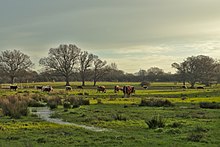
History
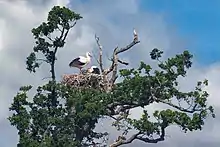
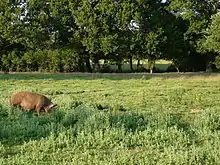
Since inheriting the 3,500 acre farm from his grandparents at the age of 21 in 1983, Sir Charles Burrell, 10th Baronet tried to run the farm profitably for 17 years. In 2000 he reluctantly decided to sell the dairy herd and farm equipment to clear mounting debts rather than take on even more debt in yet another attempt to increase the productivity.[1] The turning-point came in 2002 he received Countryside Stewardship funding to restore the 350 acre Repton-designed parkland around the mansion that had been plowed since World War II.[2]
In 2001 the 370 acres (150 ha) Repton park around the old castle was seeded with a grass and local wild meadow seeds.[3] and by the end of the year all the internal fences had been removed from the park and deer from Petworth House had been introduced.[4]
Further inspired by a visit to the Oostvaardersplassen nature reserve in the Netherlands in 2002 and the work of Dutch ecologist Dr Frans Vera,[5][6] Burrell set about establishing a 'hands-off', naturalistic grazing system across the entire estate. He used free-roaming herds of old English longhorns, Exmoor ponies and Tamworth pigs as proxies for the aurochs, tarpan and wild boar that would once have roamed the British countryside, as well as red and fallow deer.[7]
In 2003 the project received addition funding from the Countryside Stewardship Scheme to extend the park restoration to all of the Middle Block and also the Northern Block.[8] English Long Horn Cattle were added in the same year.[9] along with 6 Exmoor ponies.[10] Two Tamworth sows followed,[11] along with a further 23 Longhorn Cattle in the Northern Block in 2004.[12]
By 2006 1,100 acres (450 ha) of the Southern Block had been left completely unmanaged for between 1 and 6 years.[13] The first meeting of the steering group was held the same year.[14]
In 2009 Ravens nested at Knepp, for the first time in hundreds of years;[15] 13 out of a total of 18 UK bat species were recorded that summer[16] along with 15 ‘UK Biodiversity Action Plan Priority’ species (4 bats and 11 birds) and 60 invertebrate species of conservation importance and 76 additional species of moths.[17] By March 2009 a 9-mile long perimeter fence around the Southern Block had been completed and 53 Longhorn Cattle were introduced to the area.[18] followed shortly afterwards by 23 Exmoor Ponies, 20 Tamworth pigs and 42 Fallow deer.[19] Purple Emperor Butterflies were spotted for the first time at Knepp that year.[20] (by 2015 Knepp would have the largest breeding colony of Purple Emperors in the country).[21]
In 2010 the project received Higher Level Environmental Stewardship funding, by which time Knepp was supporting some 1% of all nesting Nightingales in the UK, only 9 years into the project.[22]
By 2011 there were some eleven singing male turtle doves at Knepp.[23] In 2016 saw first pair of breeding falcons.[24] The same year work was carried out on the River Adur within the project boundaries to remove the artificial banks and allow the river to flood the surrounding meadows in a more natural way.[25] In 2012 the Environment Agency removed the largest weir and disabled the rest.[26] and within a year Sea Trout were spotted migrating up the river.[27]
In 2016 a Black Stork, one of the rarest of birds in Western Europe was spotted.[28] and 441 species of moth are recorded.[29] Between 2015 and 2016 experts recorded 62 species of bee and 30 species of wasp, including 7 bee and 4 wasp species of national conservation importance.[30]
White Stork raised chicks for the first time in UK for 600 years at Knepp in 2020.[31]
Description
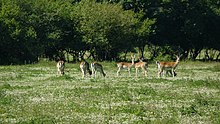
The project uses herds of free-roaming animals including Old English longhorn cattle, Exmoor ponies, Tamworth pigs, red deer and fallow deer to drive habitat generation and focuses on restoring dynamic natural processes.[33][34] The project has witnessed an 'extraordinary abundance' of many rare species, including turtle doves, barbastelle bats, slow-worms and grass snakes;[35] and is now a breeding hotspot for purple emperor butterflies and nightingales.[36][37][38]
A reintroduction programme of white storks to England is in its early stages on the estate, with juvenile birds being kept in a six and a half acre pen until maturity, when they will be released.[39] Sussex was chosen for its strong historical associations with the stork. The programme aims to establish a breeding population in Britain for the first time since 1416.[40]
The Estate is still farming, albeit far more extensively, producing 75 tonnes of low-input, organic, pasture-fed meat per annum from its free-roaming herds.[41] Wildlife tourism provides another significant income stream.[42]

Knepp offers camping, safaris and holiday accommodation.[42] There are 16 miles of public and permissive footpaths and 5 viewing platforms on the estate.[43]
The Knepp Wildland Advisory Board of over some thirty ecologists, including Dr Frans Vera and Prof Sir John Lawton, author of the 2010 'Making Space for Nature' report.[44]
The story of the Knepp Wildland project is told in the 2018 book Wilding: The Return of Nature to a British Farm which is written by Isabella Tree, who lives at Knepp and is married to Charles Burrell and helped create the Wildland project.[45]
Awards and recognition
- 2015 People Environment Achievement (PEA) award for Nature[46]
- 2015 Innovative & Novel Project award in the UK River Prize for the River Adur restoration project[46]
- 2017 Anders Wall Award for special contribution to the rural environment in the European Union[46]
- 2017 Gold, Best Guided Tour of the Year, Beautiful South Awards[47]
- The Knepp Wildland project is recognised as a Verified Conservation Area (VCA) and is a member of the Rewilding Europe Network.[46]
- Outstanding example of landscape-scale restoration in the UK Government's 25 Year Environment Plan.[48][46]
- Organic certification from the Soil Association[46]
- Sir Charles Burrell is Chair of the Beaver Advisory Committee for England and Foundation Conservation Carpathia, vice-chair for Rewilding Britain and on the board of The Arcadia Fund, Ingleby Farms Environment Committee, the Endangered Landscapes Programme and the Bronze Oak Project.[49]
Controversy
- In an article in ConservativeHome in 2016 Tim Bonner, Chief Executive of the Countryside Alliance refers to rewilding as 'ignorant, unjust and bad for the environment' based as it is on 'land use policies enacted to punish land owners and dismantle traditional land use systems' and suggests that '[r]eal conservatives should forget the dubious rhetoric of ‘rewilding’, and focus on the delivery of public goods and sustaining the cultural landscape of the British countryside'.[50]
- The National Farmers Union has rejected the idea of large-scale rewilding, suggesting that it is 'economically and socially unrealistic' but says there are opportunities for integrating some rewilding techniques, like enhancing hedgerows, into traditional farming.[51]
- Privately, senior National Trust staff say they can’t mention the 'R-word' even though they recently launched ambitious plans to “restore” 25,000 hectares of Natural Trust land.[52]
- Knepp reports of complaints from neighbours early on saying that what they are doing is 'immoral waste of land, an affront to cultural values, that we’d turned our home Knepp into an eyesore of noxious weeds and brambles.[53]
- Bramber, the male beaver escaped from Knepp Wildland early in December 2020.[54]
Gallery
 Knepp Wildland camping field
Knepp Wildland camping field A stag at Knepp
A stag at Knepp View of part of Hammer Pond at Knepp Wildland
View of part of Hammer Pond at Knepp Wildland Viewing platform at Knepp Wildland
Viewing platform at Knepp Wildland Longhorn cattle at Knepp Wildland
Longhorn cattle at Knepp Wildland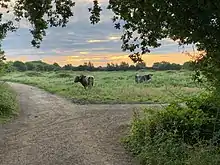 Longhorn cattle at Knepp Wildland
Longhorn cattle at Knepp Wildland Watching longhorn cattle from footpath
Watching longhorn cattle from footpath Longhorn cattle at Knepp Wildland
Longhorn cattle at Knepp Wildland
External links
- Knepp Wildland Project Homepage https://knepp.co.uk/home
See also
References
- "Background". Knepp Wildland.
- "The restoration of Knepp's Repton park".
- Tree 2018, Kindle loc 729.
- Tree 2018, Kindle loc 829.
- nl:Frans Vera
- Marren, Peter, "The Great Rewilding Experiment at Knepp Castle", British Wildlife, June 2016, Vol 27, No.5, p334
- Barnes, Simon. "The farm that went wild." The Spectator, 30 May 2015. p22.
- Tree 2018, Kindle loc 1438.
- Tree 2018, Kindle loc 1523.
- Tree 2018, Kindle loc 1580.
- Tree 2018, Kindle loc 1651.
- Tree 2018, Kindle loc 1787.
- Tree 2018, Kindle loc 1801.
- Tree 2018, Kindle loc 2258.
- Tree 2018, Kindle loc 2511.
- Tree 2018, Kindle loc 2529.
- Tree 2018, Kindle loc 2535.
- Tree 2018, Kindle loc 2626.
- Tree 2018, Kindle loc 2628.
- Tree 2018, Kindle loc 2643.
- Tree 2018, Kindle loc 2725.
- Tree 2018, Kindle loc 2842.
- Tree 2018, Kindle loc 210.
- Tree 2018, Kindle loc 219.
- Tree 2018, Kindle loc 3329.
- Tree 2018, Kindle loc 3343.
- Tree 2018, Kindle loc 3345.
- Tree 2018, Kindle loc 4404.
- Tree 2018, Kindle loc 4060.
- Tree 2018, Kindle loc 4068.
- "Wild white storks hatch in UK for first time in six centuries". Independent. 16 May 2020.
- "Beavers back in Sussex for the first time in 400 years". Country Life. 5 February 2020.
- "Knepp Wildland". Rewilding Europe. Retrieved 3 January 2017.
- "Welcome to the Knepp Estate". Knepp Estate. Retrieved 3 January 2017.
- "Rewilding: transforming conservation methods". The Ecologist. 4 November 2020.
The abundance of wildlife at Knepp is extraordinary – turtle doves, woodpeckers, sparrowhawks, barbastelle bats, slow-worms, grass snakes and butterflies have all become residents
- "The Purple Emperor in Sussex". Bufferfly Conservation - Sussex Branch.
- "Moonlit melody - the resurgent nightingales of Knepp". The Ecologist.
- "Knepp Estate". Rewilding Britain. Retrieved 3 January 2017.
- "White Storks". Knepp Estate. Retrieved 8 June 2018.
- "White storks to breed in Britain for the first time in 600 years". The Telegraph. Retrieved 8 June 2018.
- Wale, Michael. "Say no to intensive farming". Home Farmer, April 2016
- "Knepp Wildlife Safaris and Camping". Cool camping.
- "Permissive access". Knepp.
- "Advisory Board". Knepp Wildland.
- "Rewilding revives a country estate". Financial Times. 28 September 2018.
- "Recognition". Knepp Wildland.
- "A Wild Success for Knepp Wildland at The Beautiful South Tourism Awards". Horsham District Post. 7 December 2017.
- A Green Future: Our 25 Year Plan to Improve the Environment. DEFRA Policy Paper. 11 January 2018. p. 60.
- "Meet the team". Knepp Safari.
- "Tim Bonner: Ignorant, unjust – and bad for the environment. It's time to call a halt to rewilding". Conservative Home. 15 November 2016.
- "This British farm went from a 'biological desert' to biodiversity hotspot by letting the animals take charge". CNN. 5 October 2020.
- "'It is strange to see the British struggling with the beaver': why is rewilding so controversial?". The Giuardian. 3 July 2017.
- "How to Return a Farm to the Wild—And Maybe Save the Planet". Time Magazine. 3 October 2019.
- "Beaver spotted in River Adur revealed as Knepp Estate escapee". West Sussex County times. 11 December 2020.
Sources
- Tree, Isabella (2018). Wilding : the return of nature to a British farm. London: Picador. ISBN 978-1-5098-0509-9. OCLC 1035680140.